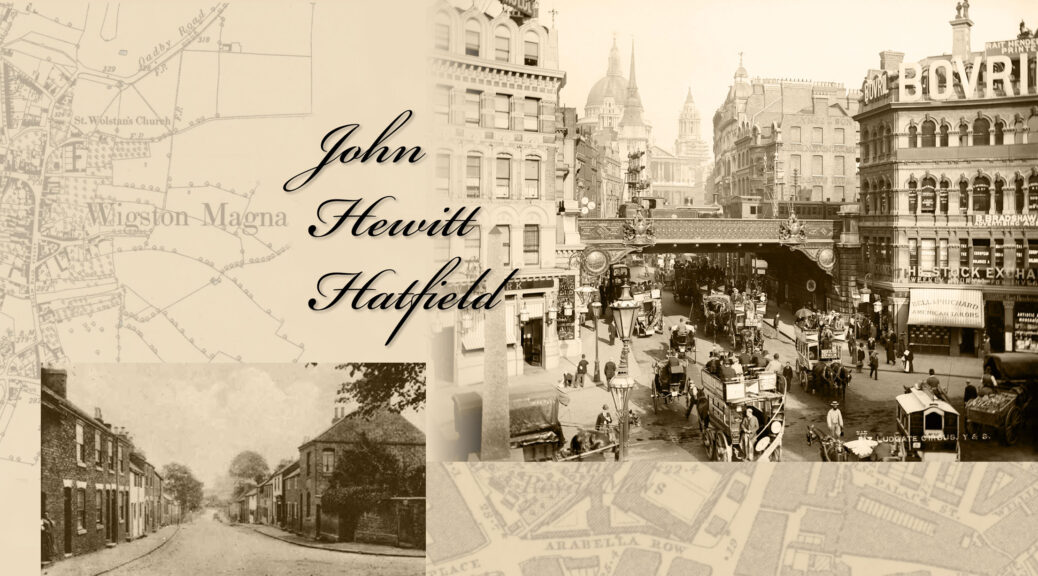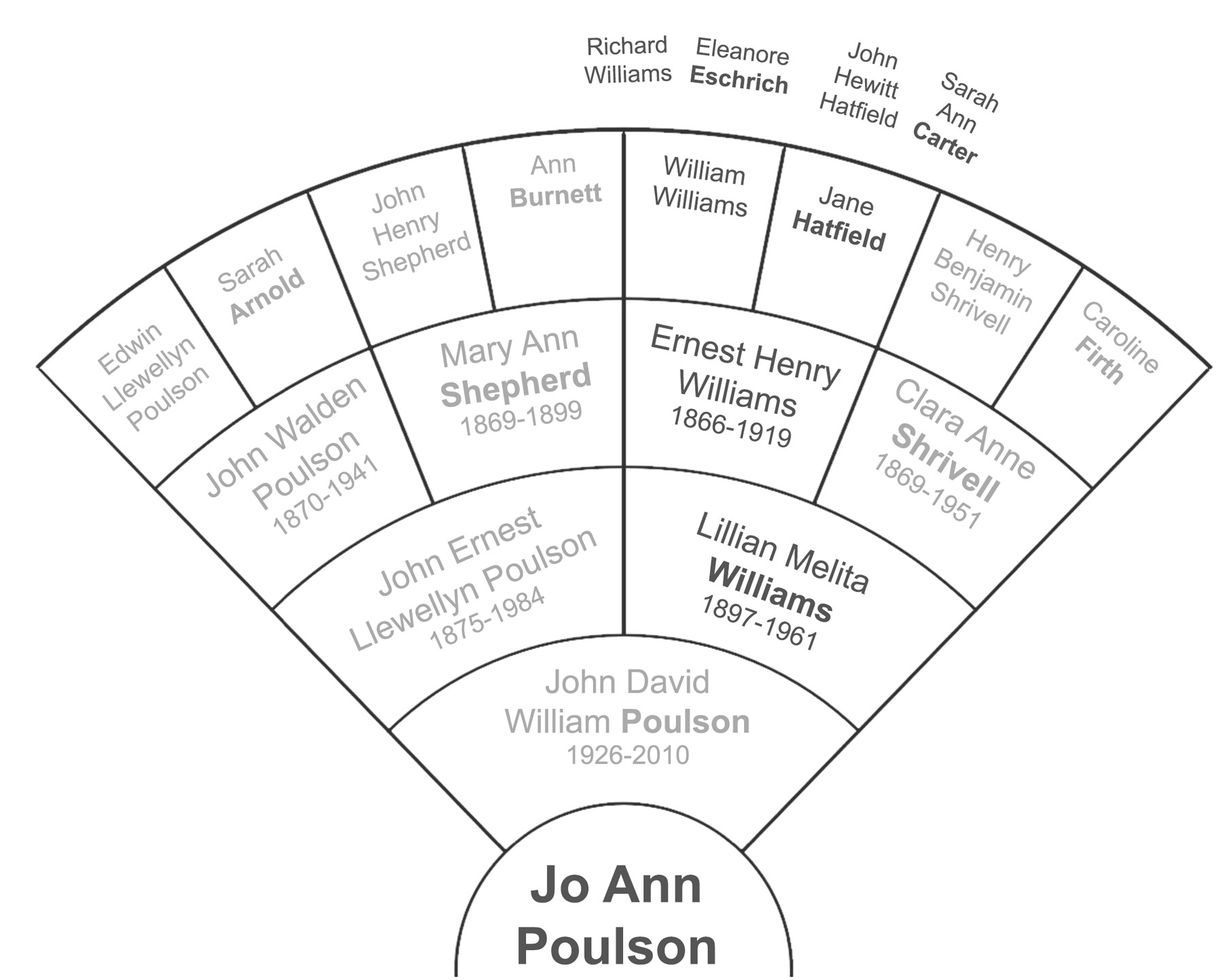
John Hewitt Hatfield is my 3rd great grandfather – his daughter Jane married the brewer William Williams. John was born in Great Wigston – or Wigston Magna – in Leicestershire in 1821 (or thereabouts). His father, John, was a watchmaker from a nearby town, Husband’s Bosworth. Adding another lovely name, John Hewitt’s father died in Kibworth Beauchamp . I think the family may have been non-conformists (i.e. not Church of England) and records of John Hewitt Hatfield’s birth or baptism aren’t available anywhere I can find. Civil registration of births, marriages and deaths only began in 1836, so without a parish record of a baptism, later census records are the only source (and as they’re self reported, they aren’t always reliable).
Economic conditions in the Leicester area were pretty dire at the time, as an excerpt below from the May 1819 Leicester Chronicle points out. I can see why a young man in the late 1830s might head for London to see if he could do better for himself.
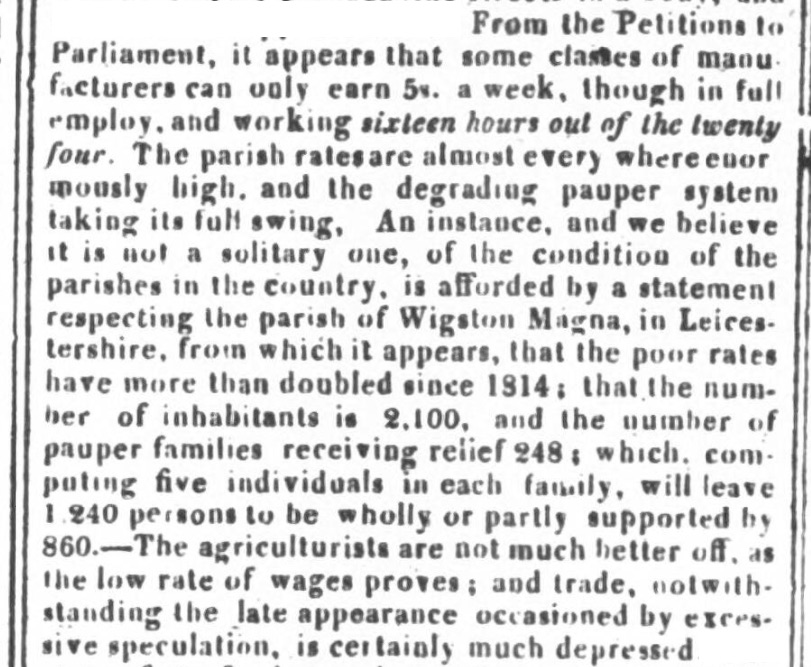
If I set aside a newspaper story from 1837 about two youths who reportedly chased home a girl after church on Sunday night (I can’t be sure if it’s the same John Hatfield), the first paperwork for John Hewitt Hatfield is the 1841 census in which he is at 11 William Street, right outside Buckingham Palace in London. The census says he is 20, as is his wife Sarah Ann, and they have a 5 month old daughter Ann. John Hewitt Hatfield told them he was a dentist – at 20! Dentistry in the early to mid 1800s was pretty dire – mainly lots of pain and tooth pulling based on what I have read – and the first dental schools didn’t open until 1859.

In October 1841, John Hewitt’s father, John Hatfield, died suddenly in Kibworth Beauchamp. There was an inquest – the cause of death was listed in amusing way, although the rather gruesome details were anything but. No mention of a widow, so I assume his wife had predeceased him. As John was buried 4 days after his death, I can’t imagine his son managed to be there.

As I started trying to put the events of John Hewitt Hatfield’s life in order, I realized the marriage record, in London, for the watchmaker John Hewitt Hatfield and Sarah Ann Carter, was dated April 1847 – they already had three children by then. Why the long delay getting married, in an age when that was frowned upon, especially in the circles the Hatfields apparently aspired to join?
An aside: both John and Sarah signed their names on the marriage certificate – it wasn’t until 1870 that education for ages 5 to 10 became mandatory, so many people’s names were written by the curate and they made an X as “their mark”. You can see the effects of public education as the decades progressed and even rural laborers could sign their marriage certificate.
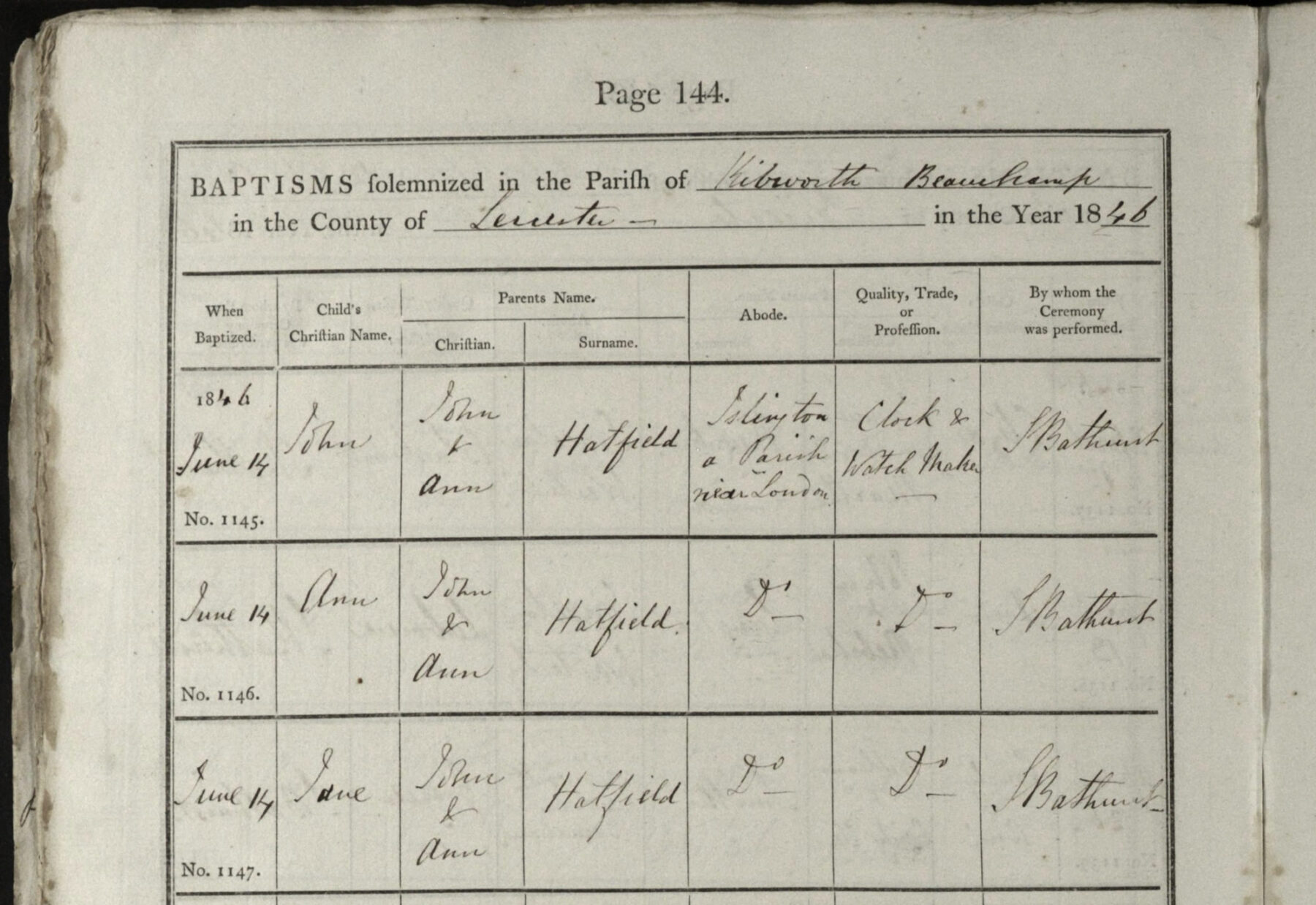
I wanted to find baptism records for the first three children – Ann born in 1841, John in 1843 and Jane in 1845. After much hunting, I found a record in Kibworth Beauchamp, Leicestershire, not Islington where they lived. On June 14, 1846, in Sarah Ann’s home parish, all three children were baptized. The unusual note in the parish register about where they lived suggests this was a special trip home to baptize all three children (the next, future doctor William Henry Hatfield, wasn’t born until April 1850). I can’t be sure of the reasons they moved to London without marrying, had three children they didn’t baptize, then ran back to Sarah Ann’s home to baptize them, but I can tell some plausible stories.
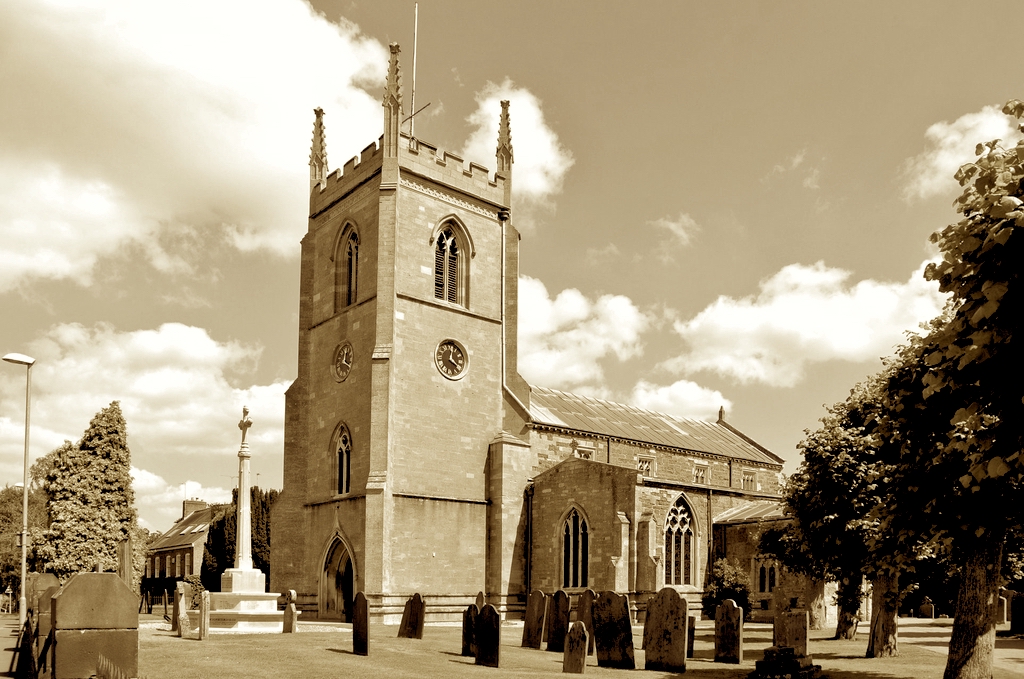
Sarah Ann would have been pregnant around Spring 1840 and John Hewitt was only 19 and would have needed his father’s permission to marry. Sarah Ann was older – 21 in August 1840 – but she’d have been pretty obviously pregnant before then and facing her family’s anger. The young couple left for London – possibly something they’d already been contemplating as economic times were hard in and around Leicester – where they could live as husband and wife and no one would be any the wiser. As time went by and more children were born (John in Kibworth and Jane in Islington) I have to believe there were lots of questions along the lines of “when will get married?”.
Perhaps Sarah Ann at some point gave up on the idea that marriage would happen and needed to have the children registered in a parish so they could get poor relief if they needed it. It’s also possible that their second child being born in Kibworth was part of a previous “it’s all over” temporary split, or just that she needed help with a toddler and a newborn in 1843 – her mother Jane was alive until 1847 and might have been a good (free) source of help.
How things were resolved – did John Hewitt take the train (very new, but I think available to Leicester via Birmingham by then) to say they would be married and the family returned to London after the baptisms? However it came about, John Hewitt and Sarah Ann were married in London the next Spring and the remaining five children were all born there.
The Hatfields didn’t get married just anywhere though, but at the very fashionable St. George’s Hanover Square “St. George’s Church is centered right in the middle of Mayfair, in Regency times The place to live when in Town. “ Was the posh venue to make up for the long wait? The streets are more crowded now, but that huge church is still there should you wish to Google it for more pictures
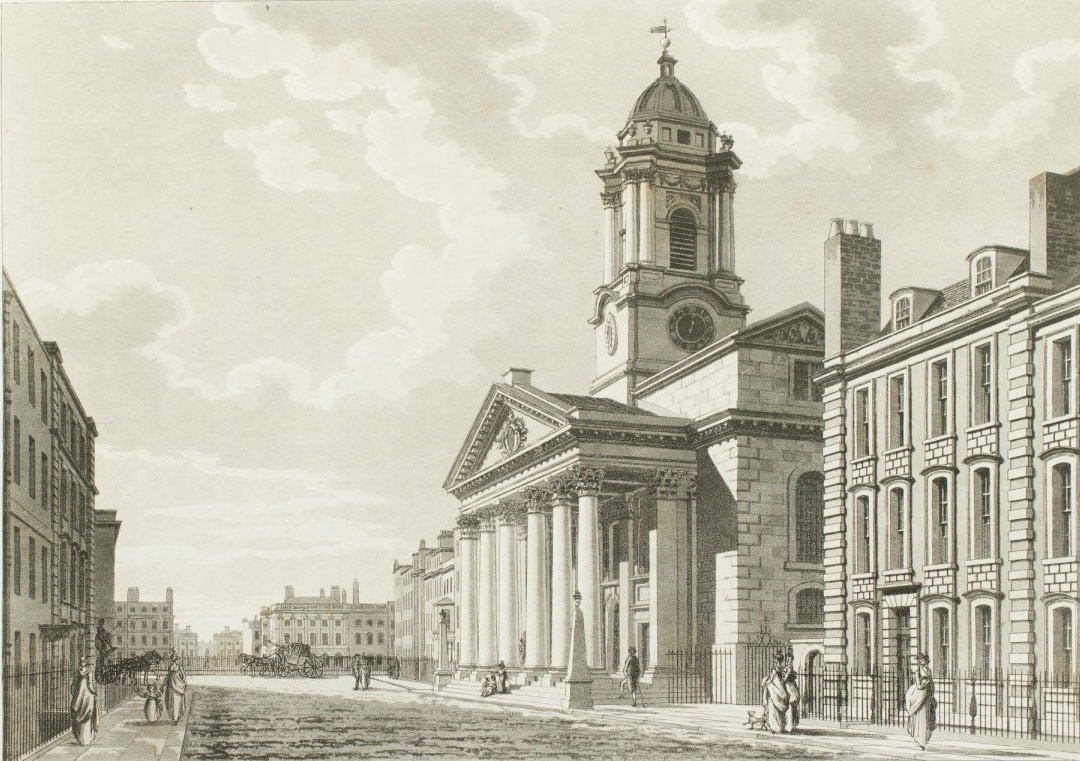
You can read more about the church and its history – I found the notion that a tax on coal paid for it rather regressive and “let them eat cake”, but I digress – and this illustration from 1841, while of someone else’s wedding, illustrates what the young couple might have aspired to as they started their life in London. Clearly they had dreams way above their current income level!
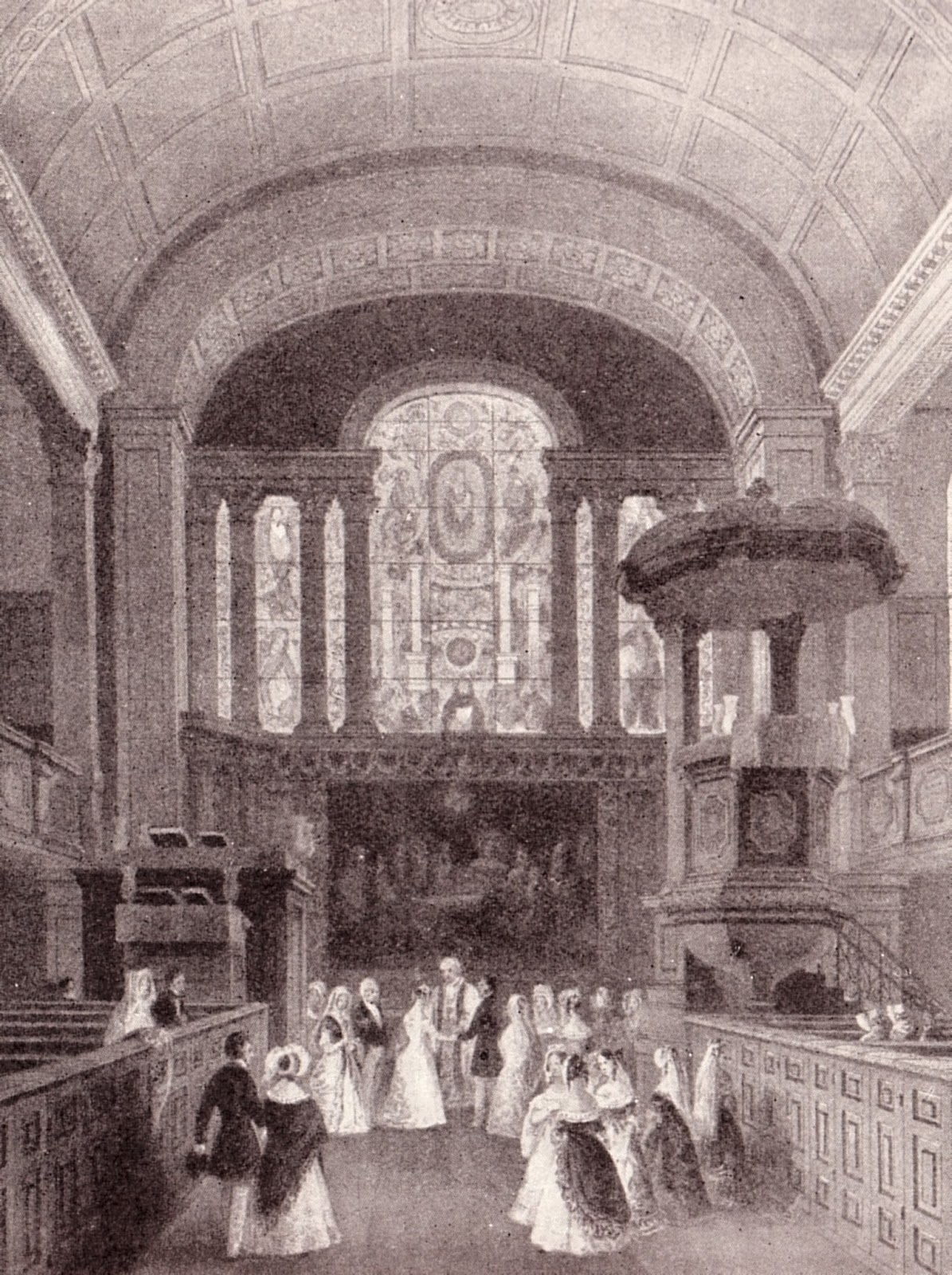
By the 1851 census, John Hewitt Hatfield and Sarah Ann are 30 and have four children; they’ve moved to 20 Barnsbury Row in Islington and occupation is again “Dentist”. As there were no rules about who could say they were a dentist until an act in 1878, it’s not clear why he switches between watchmaker and dentist. The first dental qualifications were issued in 1860 and by 1863, John Hewitt Hatfield is a Licentiate in Dental Surgery, Royal College of Surgeons, England. The watchmaker’s son from Great Wigston had come quite a way at 42.
in 1861, the family has moved up to 29 Lloyd Square in Finsbury and have a servant and a nursemaid. All six girls are at home, but the two boys have moved away. John is a hosier’s assistant in Kingston-upon-Hull and William Henry is a pupil at the Church House School in Ealing.
In 1871, they’ve moved up again – to 25 Old Burlington Street. John Hewitt is a “Surgeon Dentist” presumably as a result of his 1863 qualification. William Henry is 21 and an undergraduate; also the only child still at home. There are two servants and a lodger, a German 35-year-old Commission Merchant (no clue what that means other than commissioned sales). Daughters Ann and Jane are married; Clara, 17, is at a school in Brighton; Mary became a governess and teacher; Ada is a mystery, and the youngest, Fanny, had died age 3 in 1862.

William Henry Hatfield finished his medical education in 1873, but in 1872 he took a gap “year” and became ship’s surgeon. I’d love to know whether he was thinking of giving up his medical education, or just wanted to see the world a bit, but I wonder how he felt about his choice when co-signing log entries after one sailor stabbed another in the left buttock in a fight. His medical directory entries have his father’s Old Burlington Street address suggesting they practiced together, at least for a while.
William Henry was also listed in the dentists register – qualification listed was being in practice prior to 1878, so I assume he had helped his father and kept up his registration to be able to continue, if needed. He briefly moved to Hambleton, Hampshire in the early 1880s, but returned to London. William Henry’s son, Henry Francis, also became a doctor. If you look at the following map of Forest Hill, it’s littered with Hatfields and Williamses – Jane Hatfield, William Williams’ wife, and Walter Richard Williams, her son and William Henry’s cousin, were all within walking distance of one another. When Walter Richard Williams was married in 1904, he listed his cousin Henry Francis Hatfield’s address on the marriage certificate.
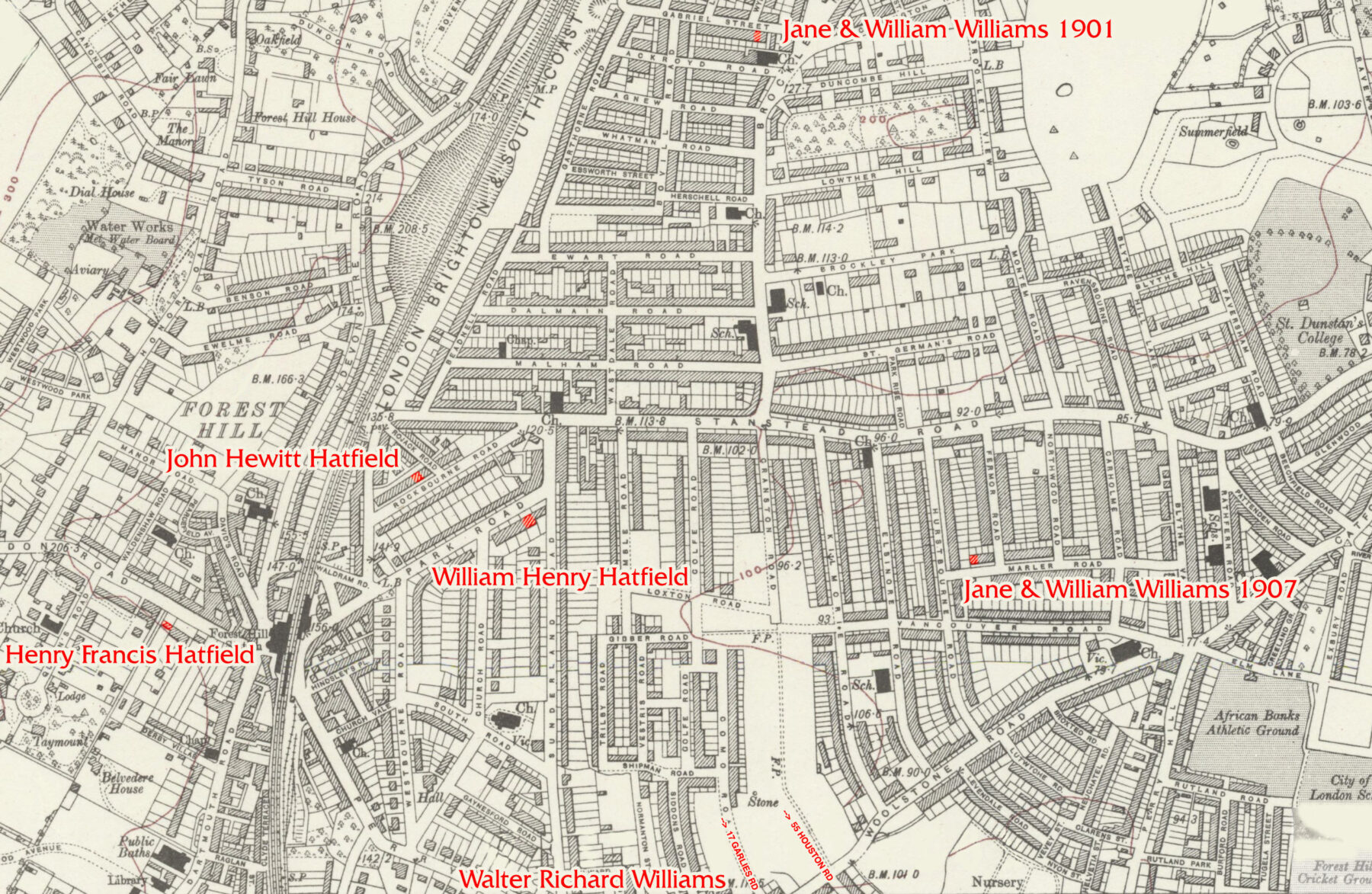
John Hewitt Hatfield moved his residence out of central London in 1891, to Byrne Road in Sydenham, but appeared still to practice at 25 Old Burlington Street. He didn’t list himself as a “Retired Dentist” until the 1901 census – he was then 80 years old. He died in 1904 and Sarah Ann in 1908.
When William Williams, John Hewitt’s son-in-law, died in 1907 it was William Henry Hatfield who signed the death certificate. Walter Richard Williams (then on Houston Road) reported his father’s death. When Jane Williams died in 1931, it was her nephew, Henry Francis Hatfield who signed her death certificate. Having family close by must have made things much easier. A very long way from Wigston Magna and Kibworth Beauchamp, but they’d made a new home for themselves in the capital.

